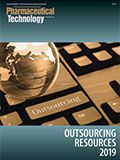Gene-Editing Techniques Target New Applications
Industry experts discuss the role of gene-editing techniques in regenerative medicine and cell-line development.
VCHALUP - STOCK.ADOBE.COM

Gene-editing methods such as clustered regularly interspaced short palindromic repeats (CRISPR)-Cas9 are used for disease research; clinical studies using the method are ongoing. A growing use of CRISPR-Cas9 and other gene-editing techniques to modify the genetic makeup of mammalian-based cells, such as Chinese hamster ovary (CHO) cells, is used for therapeutic antibody production.
To explore the role gene-editing techniques can play in regenerative medicine and cell-line development, BioPharm International interviewed Lise Munsie, senior development manager at CCRM, a Toronto, Canada-based not-for-profit consortium that supports the development and commercialization of cell and gene therapies and regenerative medicine-based technologies, and Kevin Gamber, vice-president of Canopy Biosciences, a St. Louis, MO-based life-sciences company that offers tools and services for gene editing and bioprocessing applications.
Application of gene-editing tools
BioPharm: What is the most commonly used genome-editing tool today; how has this tool impacted the development of cell lines for use in therapeutic antibody production?
Munsie (CCRM): Although CCRM does not currently make therapeutic antibodies, the ability of CRISPR-Cas9 to easily manipulate the genome of antibody producing cells, such as CHO cells, to enhance antibody production would be game-changing. Scientists can easily alter genes they think are assisting the cells in antibody production, for instance, by manipulating genes that regulate the cell cycle or divert energy from other normal cellular processes towards antibody production. Prior to CRISPR-Cas9, this [manipulation] would have been too cumbersome to do in an efficient and relevant manner.
Gamber (Canopy Biosciences): CRISPR-Cas9 has taken the gene editing world by storm. It is more efficient and much easier to design and construct than previous gene-editing tools, such as zinc finger nucleases (ZFNs), [Transcription Activator-Like Effector Nucleases] TALENs, and meganucleases. For therapeutic antibody production, it has been used both for site-specific integration of antibodies for bioproduction as well as to generate better host cells; the development of cells with increased yields, for example.
BioPharm: What other genome-editing tools are predominantly used today by the biopharmaceutical industry for cell-line engineering?
Munsie (CCRM): There are classic tools like ZFNs and TALENs. Scientists are increasingly making modified-Cas9 variants to make them more specific or efficient, and new enzymes that function in a manner similar to Cas are regularly being discovered.
Gamber (Canopy Biosciences): ZFNs are also used. ZFNs have a clearer intellectual property position than CRISPR. Additionally, stable cell lines are still being generated through standard transgenic technique-transfection of a transgene followed by selection.
Pitfalls and potential
BioPharm: What are potential pitfalls or disadvantages of using a genome-editing tool to custom engineer CHO cells?
Gamber (Canopy Biosciences): The off-target effects generated by CRISPR-Cas9 have been well documented. Off-target effects occur when the gene editing tool makes unintended edits to other genes in addition to the target gene. Off-target editing is not species specific. Off-target effects can be largely mitigated through careful design of the reagents.
BioPharm: Will genome-editing technologies continue to play a significant role in customizing cell-line development, or are other technological tools expected to break through?
Munsie (CCRM): Gene editing is still in its infancy and will continue to be a major player in the cell-line engineering field for a long time to come.
Gamber (Canopy Biosciences): Gene editing via CRISPR-Cas9 will continue to be an extremely important tool for gene editing. Improvements on the technology are continuing to be made, as well as alternate systems being identified. Therapeutic use of CRISPR-Cas9 technology, such as Chimeric antigen receptor T cells as immunotherapy for cancer, will increase in use and hopefully become a powerful new approach to a wide variety of diseases.
BioPharm: What needs remain unmet in biologic drug engineering/development, and can genome-editing tools address these unmet needs?
Munsie (CCRM): Most regenerative medicines rely on autologous stem cell sources due to the immune response that occurs when allogeneic cells are introduced into a person. However, there is a lot of interest in using CRISPR-Cas9 to manipulate allogeneic cells and knock-out proteins that signal the immune system. These cells could then be used in multiple donors for many different therapies without the issue of rejection. Additionally, genome-editing can be used to knock-in genes. In the case of universal cells, it would be desirable to knock-in an exogenous gene that could be used as a kill switch in the event your regenerative medicine therapy had ill-intended effects.
Article Details
Pharmaceutical Technology
Supplement: Outsourcing Resources
August 2019
Pages: s36–s37
Citation
When referring to this article, please cite it as “Gene-Editing Techniques Target New Applications," Pharmaceutical Technology Outsourcing Resources Supplement (August 2019).

Drug Solutions Podcast: A Closer Look at mRNA in Oncology and Vaccines
April 30th 2024In this episode fo the Drug Solutions Podcast, etherna’s vice-president of Technology and Innovation, Stefaan De Koker, discusses the merits and challenges of using mRNA as the foundation for therapeutics in oncology as well as for vaccines.
Drug Solutions Podcast: Applying Appropriate Analytics to Drug Development
March 26th 2024In this episode of the Drug Solutions Podcast, Jan Bekker, Vice President of Business Development, Commercial and Technical Operations at BioCina, discusses the latest analytical tools and their applications in the drug development market.
INTERPHEX 2025: Use of Walk-In Chambers for Bio/Pharma Development and Manufacturing
April 2nd 2025Sitting down with the PharmTech Group at INTERPHEX 2025, Christopher Murphy, director of Global Business Development and Service Customer Support at Environmental Specialties, discusses the design and critical role of walk-in chambers in the bio/pharmaceutical industry.